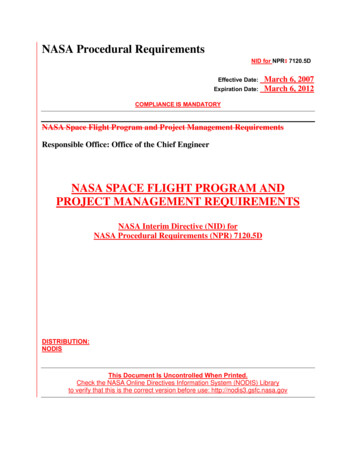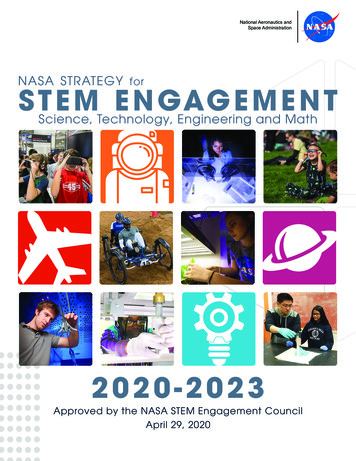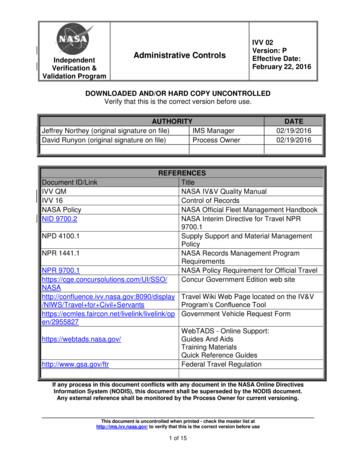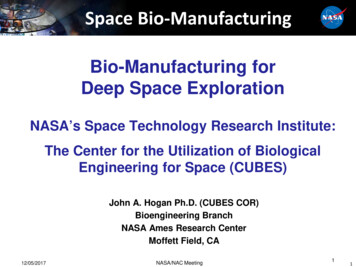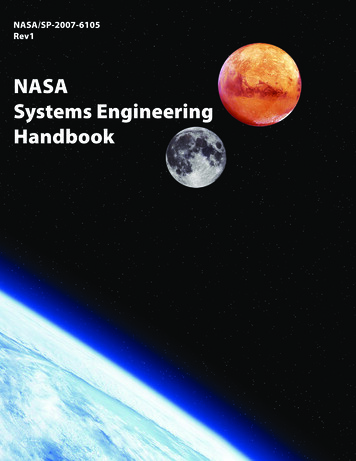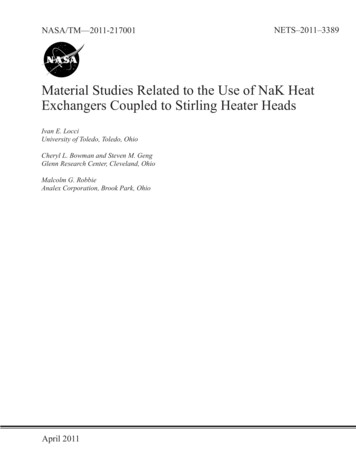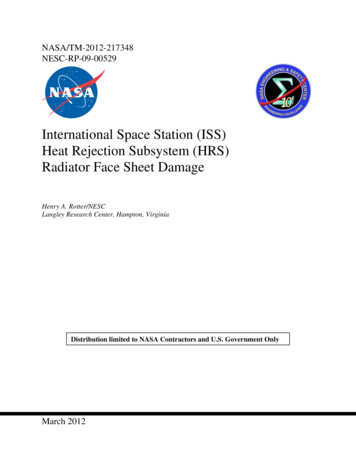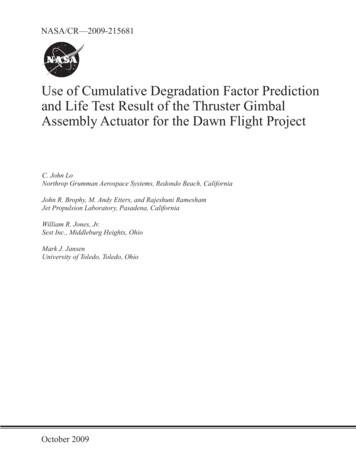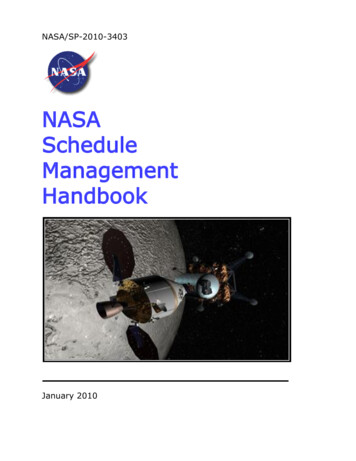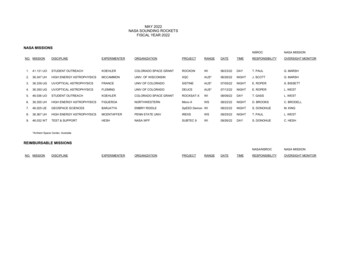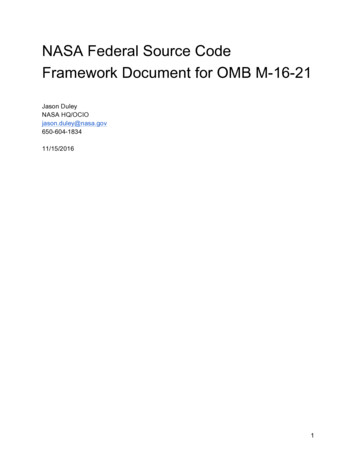
Transcription
NASA Federal Source CodeFramework Document for OMB M-16-21Jason DuleyNASA HQ/OCIOjason.duley@nasa.gov650-604-183411/15/20161
IntroductionEffective August 8, 2016, memorandum M-16-21, Federal Source Code Policy: AchievingEfficiency, Transparency, and Innovation through Reusable and Open Source Software1 wasreleased by OMB (Office of Management and Budget).M-16-21 seeks to ensure that new custom-developed federal source code be made broadlyavailable for reuse across the federal government. This approach is consistent with the DigitalGovernment Strategy “Shared Platform” approach, which enables federal employees to worktogether—both within and across agencies—to reduce costs, streamline development, applyuniform standards, and ensure consistency in creating and delivering information. The policiesin this document do not apply retroactively. M-16-21 aims to: Provide a policy to agencies on considerations that must be made prior to acquiring anycustom-developed codeRequire agencies to obtain appropriate government data rights to custom-developedcode, including at a minimum, rights to government-wide reuse and rights to modify thecode. Agencies shall make such custom-developed code broadly available across thefederal government, subject to limited exceptionsRequire agencies to consider the value of publishing custom code as open sourcesoftwareEstablish requirements for releasing custom-developed source code, including securingthe rights necessary to make some custom-developed code releasable to the public asopen source software under this policy's new pilot programProvide instructions and resources to facilitate implementation of this policyAs an agency, NASA is a leader across the federal government in sharing its software. Prior torelease of OMB M-16-21, NASA had an active and effective software release program and is anearly-adopter of open source principles. Since 2011 NASA has historically released over 20%of software as open source annually.1Federal Source Code Policy - https://sourcecode.cio.gov/2
Federal Code Sharing Process GoalsThe long-term goal of addressing and fulfilling OMB M-16-21 within NASA will be to documentthe official NASA policy in accordance with M-16-21 in a NASA Interim Directive (NID) andsupplement the NID with an implementation handbook. In order to meet the November 6th,2016 OMB Milestone 1 deliverable, NASA will publish an Office Chief Information Officer(OCIO) memo on M-16-21 on the agency’s Digital Strategy webpage along with this document.This document aims to do the following:- State each M-16-21 objective OMB mandates on NASA- For each M-16-21 objective, reference an existing NASA policy and/or convey a newpolicy NASA will create to address the mandate- Document how NASA will implement the policyNASA Policy ObjectivesOMB M-16-21 requires Federal Agencies to document both the policy and implementationapproach for each of the following objectives:1.2.3.4.5.Inventory/Publish Code Project MetadataImplement an Open Source Pilot Program/Government-wide ReuseIncorporate/Apply the 3-Step Software Solutions AnalysisObtain Appropriate Government Rights in Custom-Developed CodeDocument Exceptions for Code Release3
Inventory/Publish Code Project MetadataBackgroundAs required by OMB M-16-21, NASA is required to post a machine-readable code inventory thatconforms to the code.json schema2 cataloging metadata of code projects.Existing PolicyCurrently no NASA policy exists requiring the agency to explicitly inventory or publish amachine-readable code inventory.New PolicyNASA will inventory and publish a machine-readable code project inventory when new codebecomes available.ImplementationNASA currently provides a listing of all NASA released software (binaries and zipped/archived)on software.nasa.gov in a human readable catalog. For Open Source specifically, NASAmaintains a catalog of code-level projects on code.nasa.gov3 that disseminate code projects atthe code repository level. The code.nasa.gov site offers users the ability to search for opensource code projects by keyword and the site is powered by a community-maintained metadatacatalog hosted on GitHub.com4. This open source machine-readable catalog will feed amajority of the agency’s initial dataset instances for formulation of the code.json inventory. Asthe code.gov metadata schema is currently being designed, NASA will transform its currentOpen Source Catalog to be compliant with the OMB format per guidance by the GeneralServices Administration (GSA) code.gov team. The code.json file will be created conforming tothe code.json schema maintained by the code.gov community and led by 18F/GSA and will beupdated quarterly to reflect new software activities.Although NASA maintains an internal catalog of software projects, this catalog is sometimesincomplete as existing internal NASA software projects are not disclosed to the SoftwareRelease Authority (SRA) catalog. To address this issue and to boost internal software reuse,NASA OCIO, in coordination with Office of Chief Engineer (OCE), has implemented a FederatedCode Sharing system that will be used internally to maintain a dynamic inventory of codeprojects, improve code reuse inside of NASA and automate software disclosure .2Code.json Schema - /code-gov-web/issues/44NASA Open Source Catalog - https://code.nasa.gov/4Machine Readable/Community Driven Catalog - https://github.com/nasa/Open-Source-Catalog34
The code.json file location will be posted publicly at code.nasa.gov/code.json and will include ata minimum instances for the following: All NASA Open Source Software projects released to dateAll NASA Public software projects identified in Federated Code Sharing effortAll NASA Public and Private software projects that began in fiscal year 2017 and beyondSince the NASA software development ecosystem currently includes both open source andinternal software activities, it is important to note the relationship between NASA Private andNASA Public source code and how it will interact with the overall code inventory.Big Picture of NASA Source with respect to Code InventoryThe publishing of the code inventory will be complete on December 6, 2016 to meet the 120-daymilestone as outlined in OMB’s M-16-21.5
Implement an Open Source Pilot Program /Government-wide ReuseBackgroundAs required by OMB M-16-21, NASA shall create an Open Source Pilot Program which requiresat least 20% of custom-developed code be released as Open Source Software each year for atotal of 3 years. Additionally, NASA shall make custom-developed code broadly availableacross the Federal Government, subject to limited exceptions as documented in DocumentExceptions for Code Release found below.Existing PolicyNASA Procedural Document 2210.1C5 currently details how NASA shall release Open Sourcesoftware (NASA Procedural Requirement or NPR 2210.1C section 3.2.1 and 3.2.2) andadditionally states software should be released to the greatest extent possible and to the widestaudience possible (NPR 2210.1C section 3.1.4). This document also contains policy onGovernment-wide code release (NPR 2210.1C section 3.2.5).New PolicyNASA will release a minimum of 20% of custom-developed code as Open Source Softwareeach year based on the total number of code projects in the code inventory.ImplementationNASA has a long tradition of releasing NASA code as open source software. In 2002, NASAformed an Open Source Legal Team that currently has bi-weekly meetings on open sourcetopics. The NASA Procedural Requirements document NPR 2210.1C establishes proceduresand responsibilities for the reporting, review, assessment, and release of software created by, orfor, NASA. These procedures ensure that NASA software is reported and released according tolaw and NASA policies, with appropriate restrictions on the use and redistribution of thesoftware. The software release process is managed by the NASA Headquarters ProgramExecutive for Technology Transfer and policy implementation is carried out by the SoftwareRelease Authority Working Group (SRAWG), which along with the Office of General Counselwill be key players for implementation of OMB M-16-21 within NASA in cooperation with OCIO.Software Release reviews is performed at the nine NASA Field Centers by Center SoftwareRelease Authorities (SRAs).5http://nodis3.gsfc.nasa.gov/npg img/N PR 2210 001C /N PR 2210 001C .pdf6
Additionally, NASA is working toward designing and adopting a “develop-in-the-open” processto leverage the power of open source communities and crowdsourcing efforts as this can beappropriate in some circumstances once legal hurdles are addressed, including fiscal law.Open Source RepositoriesUpon the SRA approval to release an open source project, the SRA and code project ownersinterface with the NASA OCIO to set up an internet-visible public code repository for release ofthe code project. NASA requires code developed under this policy to be delivered to a publiclyaccessible repository hosting service or set of integrated services that are widely recognized bya large, active open source community, widely used by developers. Such integrated servicesshould meet the following criteria: Common communication featuresWIKI and/or Static Website/Templating for DocumentationIssue tracking for bug reports and feature requestsVersion control systemSource code repositories and repository browsing toolsNASA maintains most open source code projects on GitHub.com/nasa6. Although there areother legacy repository locations such as NASA web servers (e.g.:https://ti.arc.nasa.gov/opensource/projects/ ) and sites like SourceForge xec/ ), the majority of code projects released to dateare housed within the NASA section of GitHub.com (inside the NASA organization) andadministration is led by the NASA OCIO. For an exhaustive list of open source projects andtheir respected locations, please visit code.nasa.gov or inspect the Open Source g) for specific details.Software Release AuthorityNASA’s software release process is one of the best in the federal government and somethingshould hold up as a gold standard. Each NASA field center has a dedicated Center SRA who isresponsible for ensuring that all releases of software are accomplished in accordance with NPR2210.1C. The NASA SRAWG has implemented an open source release policy consistent withNPR 2210.1C and aims to encourage the broadest appropriate dissemination of NASA softwareas possible (section 1.1.2)7. A listing of Center SRA points of contact can be viewed oncode.nasa.gov.LicensesThe Agency Counsel for Intellectual Property (ACIP) located in the NASA Office of GeneralCounsel, or designee, is responsible for establishing and maintaining consistency for legalimplementation of software release policy for the Agency. This includes release of OSS as sa.gov/displayDir.cfm?Internal ID N PR 2210 001C &page name Chapter17
as various other types of software releases, which are provided under the Agency’s ModelSoftware Usage Agreements (SUAs), the legal instruments employed in releasing non-opensource NASA software. The vast majority of NASA OSS is currently released under the terms ofthe NASA Open Source Agreement (NOSA), which was produced by the Agency Open SourceLegal Team more than 10 years ago.Third-party OSS is generally released under the terms of dozens of different open sourcelicenses. As open source software is typically produced by coders who use other preexistingOSS code, license compatibility between the various code licenses becomes a significant issue.The terms of one license may not be compatible with the terms of others. For example, most ofthe Free Software Foundation’s General Public Licenses (GPL) require that all softwarederivative work improvements be released under the GPL license—a “copyleft” license. Otherlicenses also requiring that derivative works be released under their license terms are thereforenot compatible with the terms of the GPL license. Reviewing license compatibility for NASAcode that incorporates a substantial amount of code under several different OSS licenses istime consuming and labor intensive. Legal review of OSS licenses is performed by NASA FieldCenter patent attorneys.As part of implementing M-16-21, the OCIO will work with the ACIP, or designees, to identify,approve and document OSS licenses that can be readily incorporated into NASA OSS projectsto facilitate its expeditious release in an open source manner. Permissive licenses guaranteethe free use, modification and redistribution of software while still permitting proprietaryderivative works, therefore NASA software development processes should strongly encouragethe use of pre-approved OSS licenses. Permissive licenses having broad communityacceptance include Apache 2.0 License8, BSD 3-Clause “Revised” License9, and the MITLicense10. Although NASA encourages the use of incoming OSS under Permissive licenses, asmentioned above, NASA currently releases the majority of its OSS under NOSA version 1.3,which like Apache 2.0 is also considered a “copyleft” license. NOSA v1.3 differs from ApacheLicense 2.0 in that it addresses U.S. Government employee civil servant authored works byestablishing that the Government is a 3rd party beneficiary of downstream recipients.Areas NASA Will Explore to Increase Frequency of OSS ReleaseAs stated earlier, NASA has a robust software release practice that includes a significantamount of Open Source Software. However, NASA will ensure that it complies with the OMBrequirement of 20% by exploring ways to increase the amount of OSS release, if necessary. Forexample, NASA may consider making software release a requirement for the developers andalso reinforce software disclosure requirements. To accomplish this, NASA could considermaking software release a requirement for the developers and also reinforce softwaredisclosure requirements. NASA could modify the agency software development policy, opensource.org/licenses/MIT98
7150.2, as well documents NPR 7120.5 and NPR 7120.8 by putting these requirements intoprogram and project plans. It should be noted that before making any proposed change, NASAwould need broad concurrence across the agency, which includes but is not limited to OCE,Mission Directorates and Field Centers.9
Incorporate/Apply the 3-Step Software SolutionsAnalysisBackgroundAs required by OMB M-16-21, NASA is required to conduct a 3-Step Software SolutionsAnalysis as outlined in the Federal Source Code Policy guidance document11. The 3-StepSoftware Solutions Analysis requires NASA to first consider available Open Source solutionsprior to any custom-code development. If a suitable Open Source software solution is notavailable, NASA should next consider the use of COTS before custom-developed code isconsidered.Existing PolicyNASA already has a policy in place to address a variation of the 3-Step Software SolutionsAnalysis. In NPR 7150.2 section 3.9, Use of Commercial, Government, Legacy, Heritage, andModified Off-the-Shelf Software, section 3.12 Software Acquisition, section 3.14 SoftwareReuse and section 3.15 Open Source all detail the policy on use of existing Open Source andCOTS prior to custom-developed code.New PolicyNASA OCIO shall work on amending NPR 7150.2 to explicitly name the 3-Step SoftwareSolutions Analysis and, to clarify the order of applicability of the aforementioned sections in theexisting policy such that Open Source is considered first prior to are-Solutions-Analysis/10
Obtain Appropriate Government Rights to CustomDeveloped CodeBackgroundOMB M-16-21 requires NASA to obtain appropriate Government data rights to customdeveloped code. OMB and Code.gov will provide model contract language that NASA canleverage.Existing PolicyNASA typically uses standard Federal Acquisition Regulations (FAR) and NASA FARSupplement clauses to define what intellectual property (IP) rights, including both data andpatent rights, the Federal Government obtains in custom-developed code. In addition, NASAhas developed local Open Source clauses for use in procurements to address up front anyexpected use of background OSS as well as any known OSS release goals for software that willbe further developed under NASA Government funding. These clauses raise the issue of OSSlicense compatibility and raise awareness to contractors of NASA OSS release goals.New PolicyNASA will implement a new policy that will ensure NASA receives sufficient rights to customdeveloped code, so as to accomplish the goals of OMB M-16-21. Until an agency-wide NASAFAR Supplement clause can be produced and implemented, and/or Government-wide clausesare developed, the above-mentioned local Open Source clauses can be modified to addressthat under OMB M-16-21, NASA is required to release at least 20 percent of custom-developedsoftware as OSS.ImplementationNASA will continue to work on this objective at which point in the future that OMB releasescontract language and specifics on how to apply them. Additionally, NASA will work with OMBto address Bayh-Dole12 rights and request additional guidance from ole Act11
Document Exceptions for Code ReleaseBackgroundOMB M-16-21 exceptions may be applied, in specific instances, to exempt an agency fromsharing custom-developed code with other Government agencies. These same exceptionswould also prevent open source release of certain software. Any exceptions used must beapproved and documented by NASA OCIO for the purposes of ensuring effective oversight andmanagement of information technology resources.Existing PolicyNASA Procedural Document 2210.1C currently documents the NASA policy on softwareexceptions in great detail.New PolicyNo new policy is required as this objective is documented in NPR 2210.1C.ImplementationNASA OCIO is responsible for ensuring effective oversight and applying exemptions togovernment code reuse per M-16-21. Working in conjunction with the Agency ApplicationsOffice (AAO), NASA shall use “best-practices” for setting up software repository structures thatallow a clean separation of modules that can and should be individually released for greaterdissemination. This repository architecture will allow code that falls into an excepted area to beindividually scrutinized by the SRAWG. The following exceptions and considerations are part ofthe agency’s policy: Source code is restricted by law or regulationIntellectual Property Law (e.g. Patent Law)Export Asset RegulationsInternational Traffic in Arms RegulationFederal laws and regulations governing classified informationSource code would create an identifiable riskSource code release contributes to the detriment of national security, confidentiality ofgovernment information, or individual privacyStability, security, or integrity of the agency’s systems or personnelTo agency mission, programs, or operationsAgency CIO believes it is in the national interest to exempt sharing the source codeThe release of the code would interfere with or restrict the assertion of patent rights bythe Government and/or its contractorsThe release of the code is restricted due to third party rights in the code12
The code is the subject of other agency technology transfer efforts aimed at making thecode available to the public13
AcronymsACIPAgency Counsel for Intellectual PropertyAPIApplication Programming InterfaceFARFederal Acquisition RegulationsGSAGeneral Services AdministrationHQNASA HeadquartersM-16-21Presidential Memorandum: Federal Source Code PolicyNASANational Aeronautics and Space AdministrationNIDNASA Interim DirectiveNOSANASA Open Source AgreementNPRNASA Procedural RequirementOCEOffice of Chief EngineerOCIOOffice Chief Information OfficerOMBOffice of Management and BudgetOSSOpen Source SoftwareSRASoftware Release AuthoritySRAWGSoftware Release Authority Working GroupSUASoftware Usage Agreement14
Definitionscode.nasa.govThe authoritative site for NASA Open Source Code Projectscode.govThis platform is primarily intended to serve two distinct functions.First, it will act as an online collection of tools, guides, and bestpractices specifically designed to help agencies implement theframework presented in this policy. Second, it will serve as theprimary discoverability portal for custom-developed code intendedboth for Government-wide reuse and for potential release asOpen Source Software (OSS). Code.gov is not intended to housethe custom-developed code itself; rather, it is intended to serve asa tool for discovering custom-developed code that may beavailable for Government-wide reuse or as OSS, and to providetransparency into custom-developed code that is developed usingFederal funds. This discoverability portal will be publicallyaccessible and searchable via a variety of fields and constraints,such as the name of the project, its intended use, and the agencyreleasing the source code. Code.gov will be accessible athttps://www.code.gov and will evolve over time as a communityresource to facilitate the adoption of good custom source codedevelopment, sharing, and reuse practices.Custom-Developed CodeFor the purposes of this policy, custom-developed code is codethat is first produced in the performance of a Federal contract oris otherwise fully funded by the Federal Government. It includescode, or segregable portions of code, for which the Governmentcould obtain unlimited rights under Federal AcquisitionRegulations (FAR) Pt. 27 and relevant agency FAR Supplements.Custom-developed code also includes code developed by agencyemployees as part of their official duties. For the purposes of thispolicy, custom-developed code may include, but is not limited to,code written for software projects, modules, plugins, scripts,middleware, and Application Programming Interfaces (APIs); itdoes not, however, include code that is truly exploratory ordisposable in nature, such as that written by a developerexperimenting with a new language or library.NASA PrivateSource code that is not visible to NASA.gov intranet users andrequires explicit “Read” permissions to a code repository.NASA PublicSource code that is set with an access control of “anonymousRead”, meaning the code repository is viewable inside of NASAwithout requiring explicit authentication and can be cloned, forkedor reused freely within the agency.M-16-21Presidential Memorandum: Federal Source Code Policy15
MetadataA set of data that describes and gives information about otherdataOpen Source SoftwareSoftware that can be accessed, used, modified, and shared byanyone. OSS is often distributed under licenses that comply withthe definition of “Open Source” provided by the Open SourceInitiative (https://opensource.org/osd) and/or that meet thedefinition of “Free Software” provided by the Free SoftwareFoundation issive LicensesA permissive license is a software license that guarantees theability to use, modify, and redistribute the software, as long asattribution back to the original developers is provided.Source CodeComputer commands written in a computer programminglanguage that is meant to be read by people. Generally, sourcecode is a higher level representation of computer commands asthey are written by people and, therefore, must be assembled orcompiled before a computer can execute the code as a program.16
on software.nasa.gov in a human readable catalog. For Open Source specifically, NASA maintains a catalog of code-level projects on code.nasa.gov3 that disseminate code projects at the code repository level. The code.nasa.gov site offers users the ability to search for open . Big Picture of NASA Source with respect to Code Inventory

